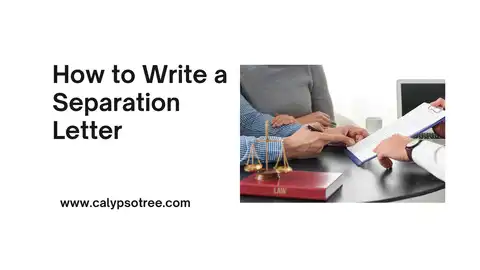“Simplify the demotion process with our free simple demotion letter templates. Get expert tips on writing, customization, and legal considerations.”
Sometimes in a job, things don’t work out as planned. If an employee isn’t doing well in their current role, a company might decide on a demotion. This can be difficult to handle, but a well-written simple demotion letter template can make the process smoother. That’s why we offer easy-to-use templates and a guide.
What’s in a Demotion Letter?
A formal document that notifies an employee of a change in their job position to a lower rank, title, or level of responsibility.
What are the essential elements of a simple demotion letter?
A simple demotion letter has a few important parts:
- Straightforward Subject: Something like “Change in Job Position” works well.
- Proper Greeting: Use the employee’s name formally (like “Dear Mr. Smith”).
- The Main Message: Tell the employee their new job title, when it starts, and if their pay or benefits are changing.
- The Reason Why: Explain the specific reasons for the demotion. Maybe they weren’t hitting performance goals, or the company is changing its structure.
- A Bit of Support (Optional): You could offer help with the change, like training or a contact person.
- Closing: Sign off with the name of an HR person or manager.
Why You need a demotion letter template?
Imagine you have to tell an employee they’re getting a demotion. It’s a tough conversation, and you want to make sure you do it right. That’s where demotion letter templates come in! Here’s why demotion letter templates are important:
- They Keep You Organized: Templates give you a clear outline. You won’t forget to include anything important, and it makes sure all your demotion letters follow the same format.
- They Protect Your Company: Templates use careful language that helps avoid legal trouble. You don’t want the employee to think they were treated unfairly.
- They Save You Time: Why start from scratch when someone already made a great demotion letter outline? You can change it a bit to fit your situation.
- They Make Things Professional: Demotions are awkward. A template helps you use the right tone – serious but also a little understanding.
How to Write Your Own Demotion Letter
Demotion letters are serious business. Here’s how to make one that’s clear, fair, and follows the rules:
Steps:
- Start with a Template: Find a simple demotion letter example online. HR websites or legal document sites usually have good ones.
- Fill in the Blanks:
- Your Company Info: Name, address, that kind of stuff.
- Employee’s Info: Their name, old job title, new job title, and when the demotion officially starts.
- Pay Changes: If their salary or benefits are changing, explain how.
- The Reason Why: Be honest but stick to facts. Did they not meet goals? Did the company change its structure?
- A Little Help (Optional): Maybe offer a contact person for their questions.
- Keep it Professional, but Kind:
- Use Formal Words: But in a way that sounds normal.
- Be Direct: Don’t try to hide the bad news.
- Show Some Understanding: Like, “We know this is difficult…”
- Check with a Lawyer (If You Can): Especially if things are complicated, this helps you avoid getting sued.
Other Things to Think About:
- Talk in Person First: If you can, explain the demotion face-to-face before giving the letter.
- Are There Other Options? Sometimes you can give an employee a plan to improve before demoting them.
Simple Demotion Letter Templates
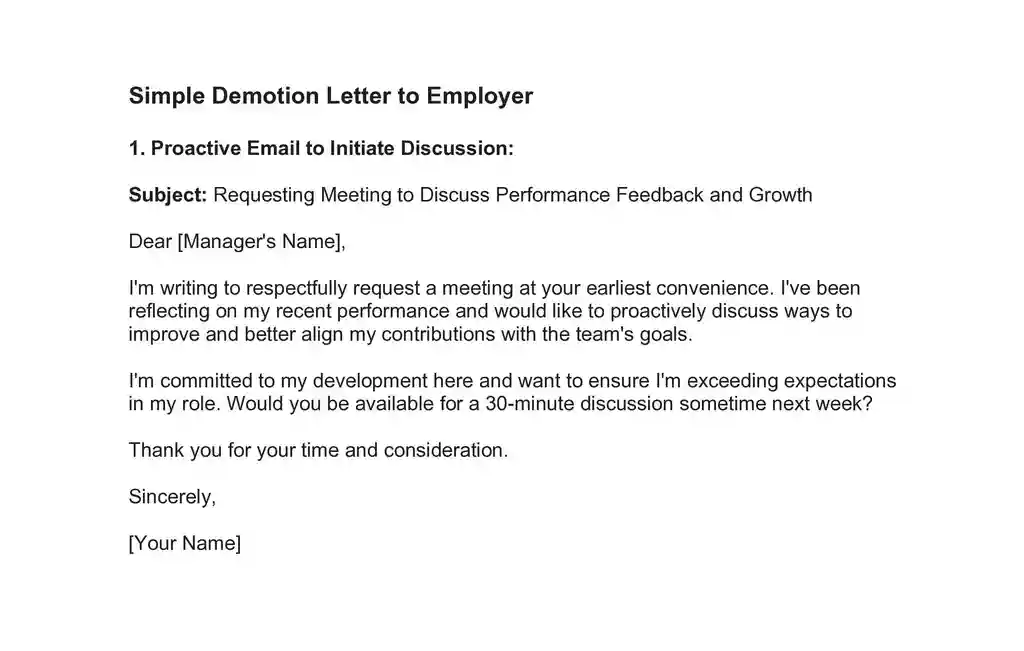
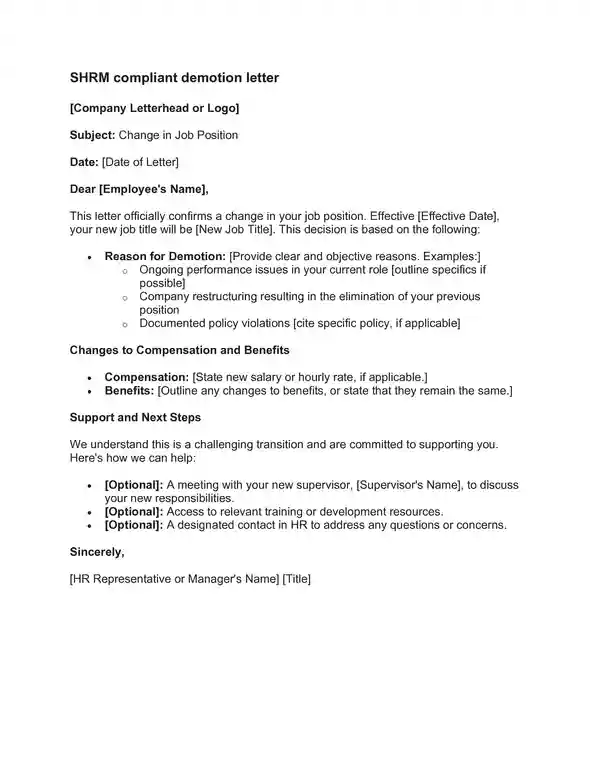
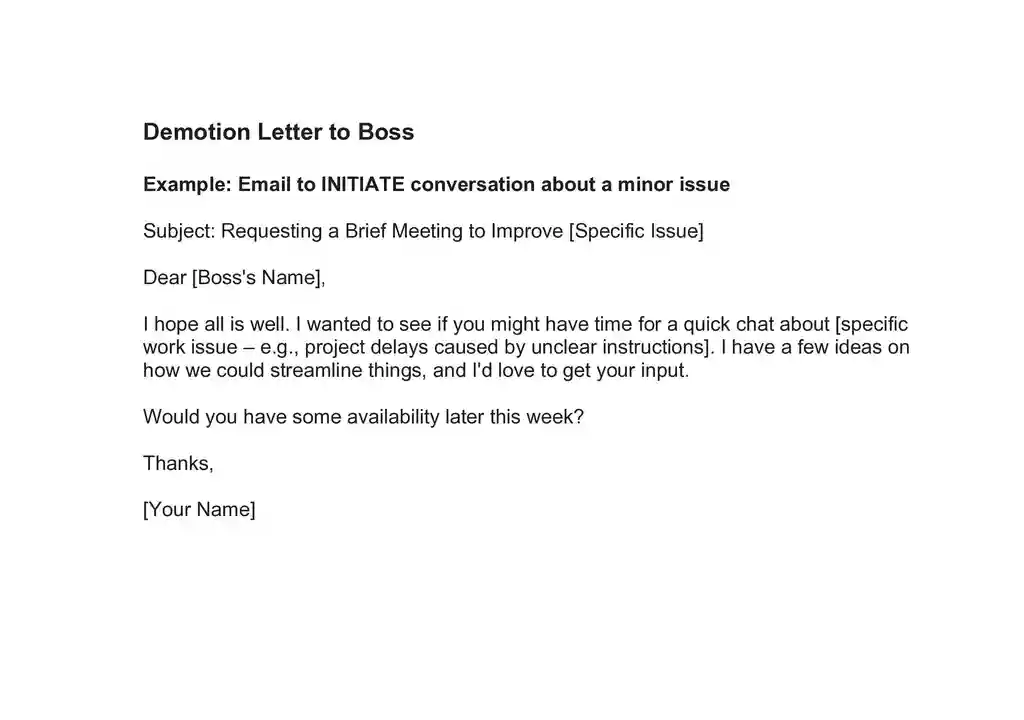
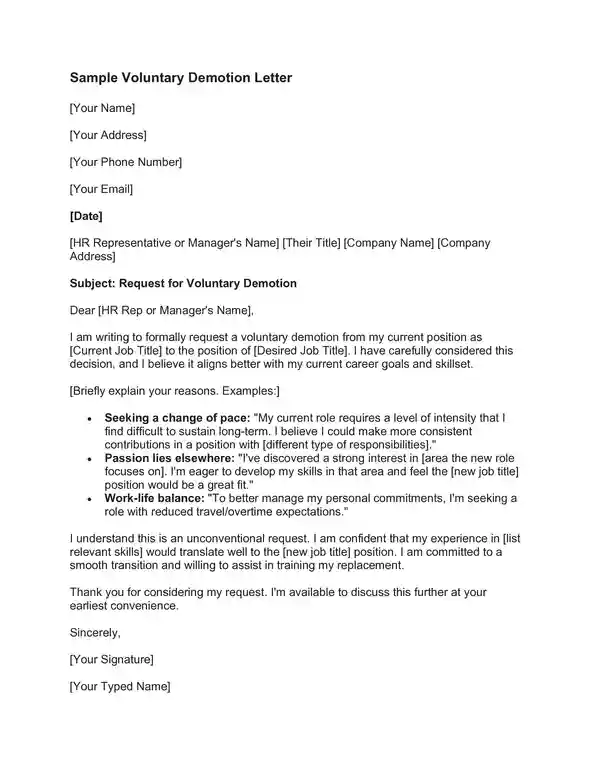
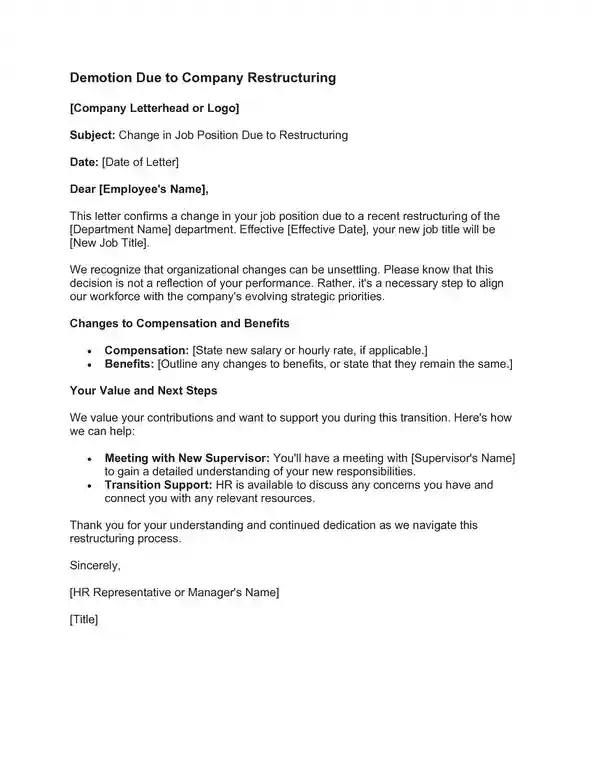
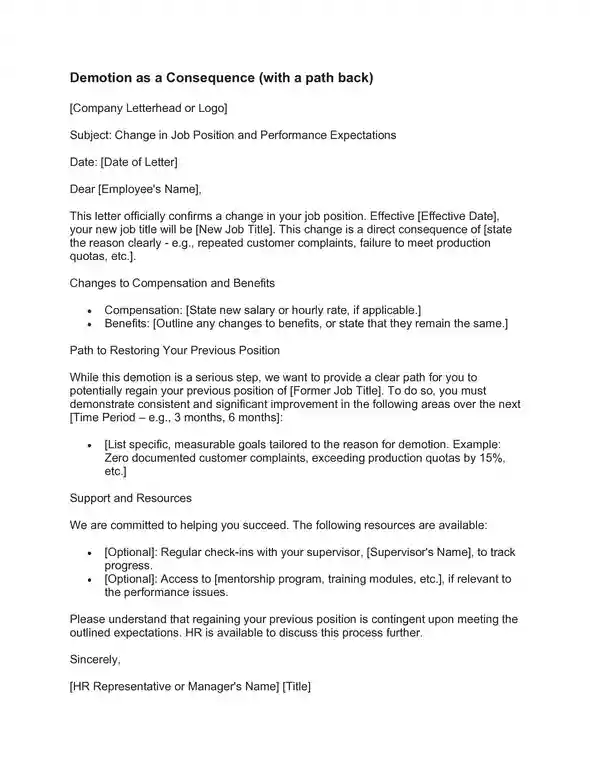
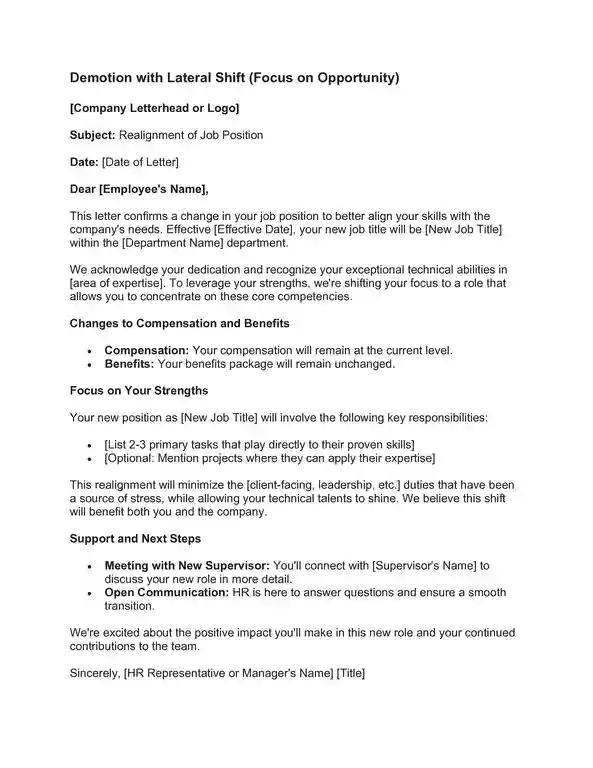
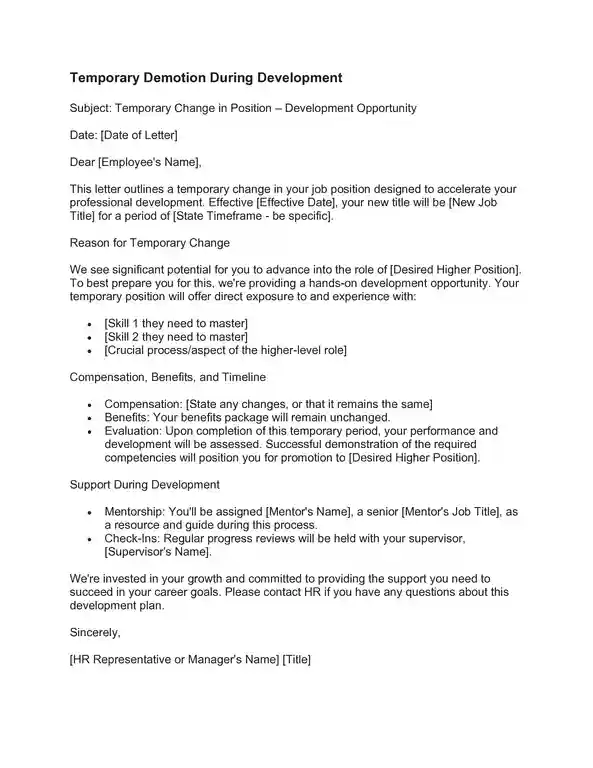
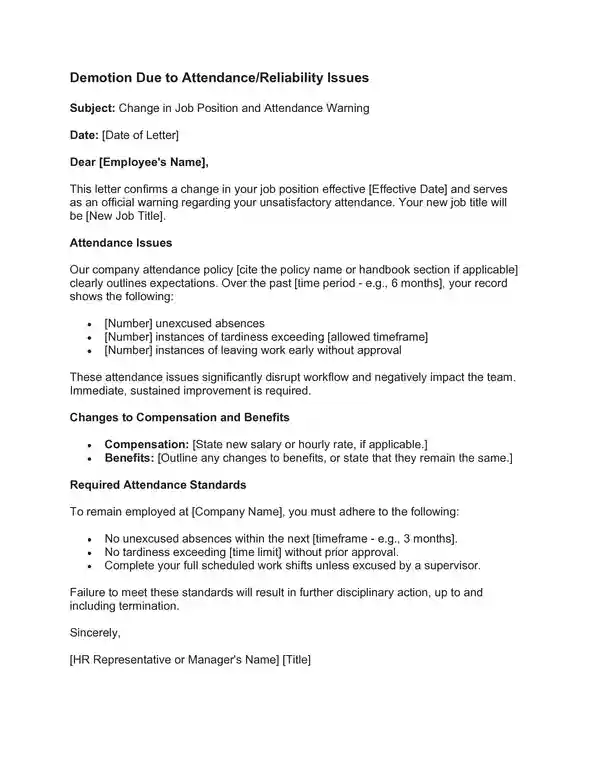
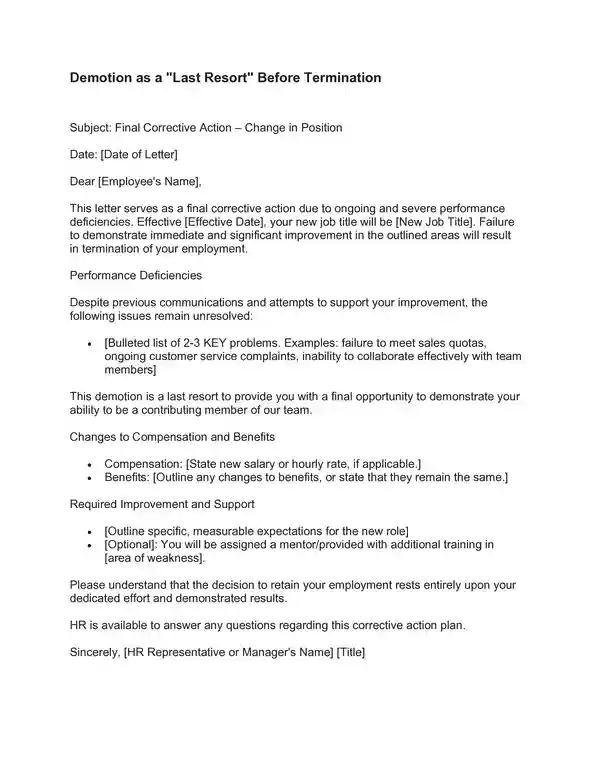
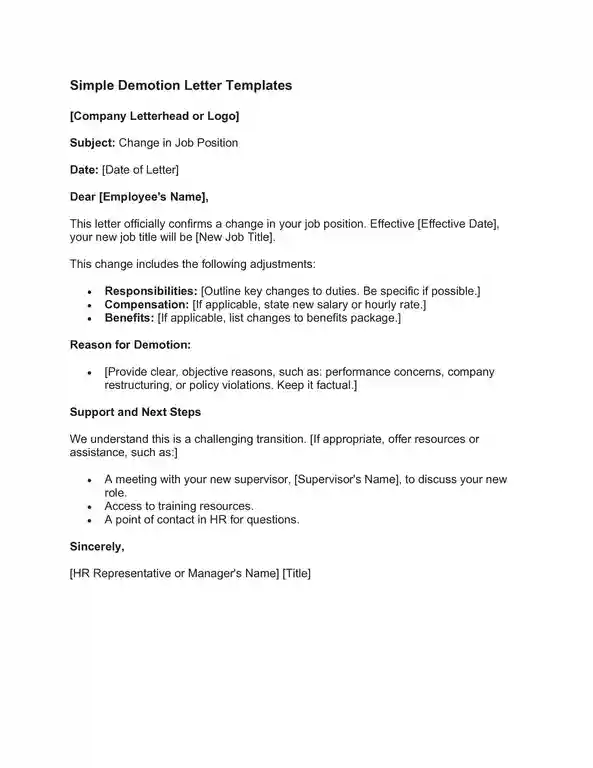
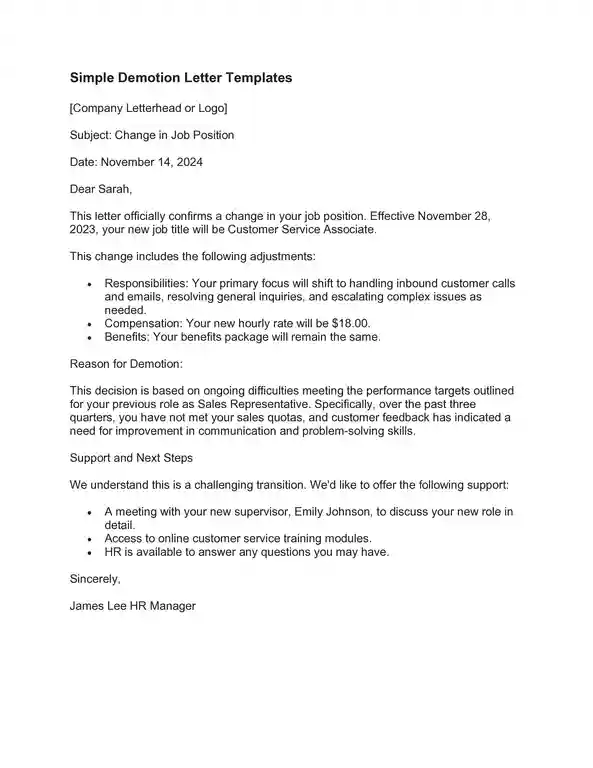
Who should You send a demotion letters to?
Typically, you would only send a demotion letter to the employee being demoted. Here’s a breakdown of why and other possible scenarios:
The Demoted Employee (The Main Recipient):
They need official documentation of their change in job title, responsibilities, and any changes to compensation. This is for their records and protects the company in case of later disputes.
Possible Additional Recipients:
Human Resources (HR):
A copy of the demotion letter should be placed in the employee’s official HR file to document the change and the reasons behind it.
Payroll Department:
If the demotion involves a change in salary or benefits, Payroll needs to be informed to make the necessary adjustments.
The Employee’s New Manager:
If the demotion also involves a reassignment to a new team or department, their new supervisor should be aware of the transition and the employee’s background.
Giving the Letter to the Employee
The moment you hand someone a demotion letter, things get emotional. Here’s how to handle it in a way that’s respectful but also gets the job done:
The Ideal: A Face-to-Face Meeting:
- Set a private space: No one else needs to hear this conversation.
- Be direct but kind: Explain the demotion clearly, along with the reasons. Don’t beat around the bush.
- Allow for questions: The employee will probably be upset or confused. Let them ask questions and try to answer as honestly as possible.
- Then, hand over the letter: This makes the demotion official.
When Email Is the Only Option:
- Craft it carefully: Your email needs to be extra clear and professional. Avoid sounding cold or harsh.
- Subject Line Matters: Something like “Important Update Regarding Your Position”
- Consider timing: Don’t send a demotion email at the end of a workday or right before the weekend.
Even if in-person isn’t possible, try to schedule a phone or video call to follow up on a demotion email. It adds a personal touch.
How to Demote an Employee
Here’s the breakdown of how to demote an employee, focusing on the key points:
Demoting an Employee: Steps for a Smooth Transition
- Document Thoroughly:
- Demotion Letter: States the new job title, effective date, any pay/benefit changes, and the reasons for the decision. This protects you legally.
- Communicate Clearly:
- Face-to-Face Meeting: The most respectful way to deliver the news. Allows for questions and some explanation from you.
- Be Direct but Kind: Explain clearly, stick to facts, and offer some understanding of the difficulty (without taking full blame).
- Get HR Involved:
- They Know the Rules: Ensures you follow company policy and avoid common legal mistakes.
- Support the Transition
- Handoff Tasks: Help the employee wrap up old projects and prepare for their new role.
- Offer Resources (If Appropriate): If the demotion wasn’t about bad behavior, transition help shows you still value the employee.
Important Laws to Remember
Demotions can get messy, especially if an employee thinks they were treated unfairly. Here’s the deal:
- No Discrimination: You can’t demote someone because of things like their race, gender, religion, age, or disability. That’s straight-up illegal.
- Company Policies: Did your company promise certain things in the employee handbook? You have to follow those rules when making changes to someone’s job.
- Confusing Laws: Stuff about contracts, fair pay, and employee rights gets super tangled. Each state might even have different rules!
When to Get a Lawyer Involved
- Something Feels Wrong: If you’re worried you might accidentally break a rule, a lawyer can explain it clearly.
- Angry Employee: If the employee threatens to sue, definitely get legal help.
- High Stakes: Big companies with lots of employees usually play it safe by having lawyers check their demotion letters.
Important: This isn’t legal advice! A real lawyer knows all the specific laws for your situation.
Other Ways to Help (Before Taking the Big Step)
Demotions should be a last resort when someone’s really struggling. Here are other things to try first:
The Performance Improvement Plan (PIP):
- What it is: A step-by-step plan with clear goals for the employee to get back on track.
- How it helps: Sets expectations and gives them a chance to prove themselves.
Is There a Better Fit Somewhere Else?
- Different Skills: Maybe the employee is great, just in the wrong role. Is there an open job they’d be awesome at?
- Change of Scenery: Sometimes, a transfer to a different team or department can spark new motivation.
Why Bother With Other Options?
- Fairness: It shows you tried to help before taking something away from the employee.
- Keeps Good Workers: Maybe with a little support, you can turn them into a star player!
- Legal Stuff: If an employee thinks you didn’t try to help, it could mean trouble if they fight the demotion.
Always check your company rules! They might have policies about when you need to try a PIP before a demotion.
What is the best tone for a simple demotion letter?
The best tone is balance between professionalism, directness, and a hint of empathy. Here’s why:
- Professional: A demotion is a serious business matter and your letter should reflect that. Use formal language and avoid overly emotional phrasing.
- Direct: Clearly state the demotion, its effective date, changes to salary/benefits, and the reasons behind it. Don’t beat around the bush, as that can cause confusion and frustration.
- A Hint of Empathy: Acknowledge that this situation is difficult for the employee. A simple phrase like, “We understand this is a challenging transition…” shows some understanding without admitting fault.
Why this balance is important:
- Clarity and Fairness: Being direct avoids misunderstandings and potential legal issues.
- Respect: A touch of empathy shows you recognize the impact the demotion has on the employee. This can help maintain a more positive working relationship going forward.
- Protection: Professionalism and clear language help protect your company in case of a later dispute with the employee.
Example:
Instead of saying, “Due to your continued poor performance…”, you could phrase it as: “Because of ongoing difficulties meeting performance targets, your position will be changing to…”
Common Mistakes And How To Avoid
Here’s some common mistakes when writing demotion letters and how to avoid them:
Key Mistakes
- Vagueness: Be direct about the new job title, start date, and any salary adjustments.
- Harsh Language: Avoid blaming or overly critical words. Stick to the facts behind the demotion.
- Ignoring Rules: Follow your company’s policies and procedures for handling demotions.
- No Legal Check: Get advice from HR or a lawyer, especially for complex situations.
- Zero Support (Sometimes): If possible, offer resources to help the employee with the transition.
Solutions
- Clarity: Use simple, unambiguous language.
- Objectivity: Focus on performance data, company reasons, or policy violations.
- Follow Policy: Know your company’s rules.
- Get Help: Consult with HR or a lawyer for guidance.
- Some Empathy: Acknowledge the difficulty of the situation (without admitting fault).
Let me know if there’s a specific part of this section you’d like me to focus on even further!
The Takeaway
Navigating demotions professionally is important for both your company and the employee. Get our free simple demotion letter templates for a clear, professional demotion process. Contact your HR department for personalized guidance.

The content creator team at calipsotree.com is dedicated to making topics accessible to everyone, with over 9 years of experience in writing and breaking down complex concepts into easy-to-understand articles that answer readers’ financial questions.








